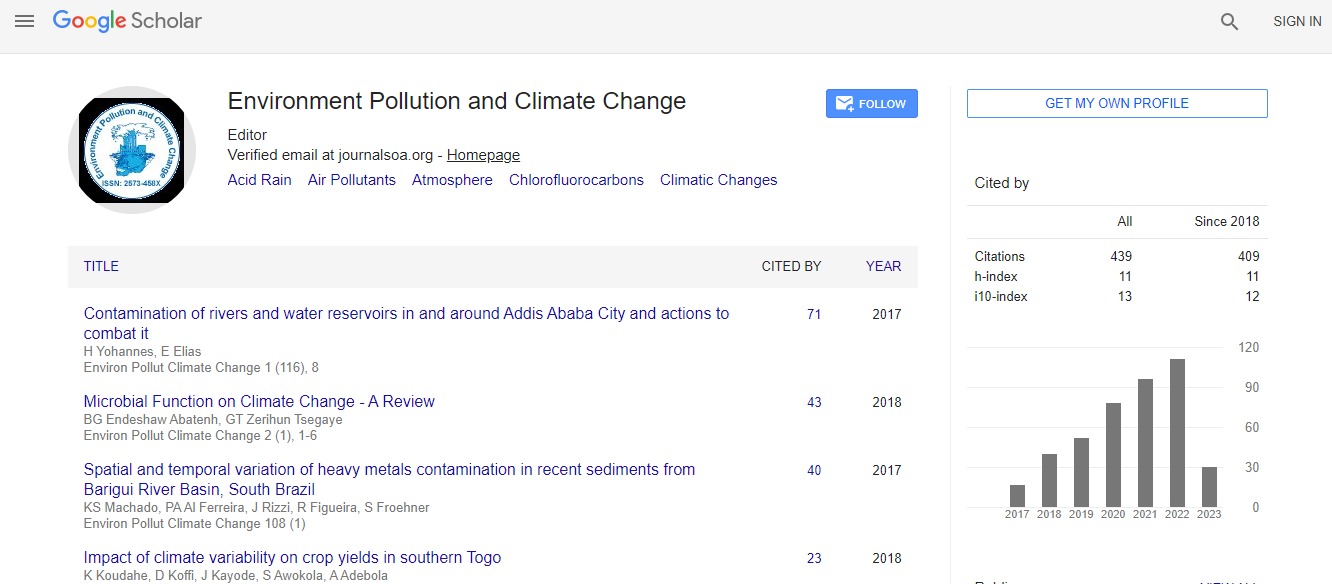Our Group organises 3000+ Global Conferenceseries Events every year across USA, Europe & Asia with support from 1000 more scientific Societies and Publishes 700+ Open Access Journals which contains over 50000 eminent personalities, reputed scientists as editorial board members.
Open Access Journals gaining more Readers and Citations
700 Journals and 15,000,000 Readers Each Journal is getting 25,000+ Readers
Google Scholar citation report
Citations : 672
Environment Pollution and Climate Change received 672 citations as per Google Scholar report
Environment Pollution and Climate Change peer review process verified at publons
Indexed In
- Google Scholar
- Publons
- Euro Pub
- ICMJE
Useful Links
Recommended Journals
Share This Page
Functional neuron-specific endpoints for in vitro neurotoxicity testing
Joint Event on 5th World Conference on Climate Change & 16th Annual Meeting on Environmental Toxicology and Biological Systems
Manuela Marcoli
University of Genova, Italy
Keynote: Environ Pollut Climate Change
Abstract
Statement of the Problem: In accordance with 3Rs, alternative models are required to replace standard neurotoxicity testing. Highcontent, high-throughput tools are needed considering specific features of nervous system (NS) functioning to identify neurotoxic vs. cytotoxic effects. By considering intercellular communication through transmitters and transmitter sensors (receptors), and collective behavior of neuron network as relevant NS functional features, the purpose of this study is to develop tools providing neuron-specific endpoints. Methodology & Theoretical Orientation: A multi-disciplinary electrophysiological, neurochemical and immunocytochemical approach, combining electrical activity recording of neuron network (on engineered micro-electrode arrays (MEAs) equipped with 60 electrodes onto which cerebrocortical neurons were cultured; data analysis through a home-made software and measurement of transmitter release was used to assess network maturation and to detect effectiveness of neuroactive/neurotoxic substances. Findings: During network development, maturation of glutamatergic/GABAergic neuron networks, target for relevant neurotoxicity mechanisms (excitotoxicity) and drugs classes, was observed. In mature networks, synaptic connectivity was related to activation of glutamatergic pathways, and the system behaved as a sensitive sensor of glutamatergic transmission functioning. Activation or blockade of NMDA/AMPA receptors, or blockade of glutamate transporters, induced firing and bursting activity variations related to the effects on transmitter release. Also, the network sensed the fine transmission variations involved in synapse plasticity: the collective network behavior and glutamate release were controlled by NMDA-dependent NO-cGMP pathway, as indicated by its pharmacological manipulation (NO synthase/guanylyl cyclase inhibitors, NO donors/8Br-cGMP). By presenting examples of network activity modulation by neuroactive substances (glutamate/GABA receptor agonists/antagonists) and by known neurotoxicants (e.g., domoic acid, chlorpyrifos oxon), and ineffectiveness of molecules not exhibiting acute neurotoxic effects, we report evidence that MEAs-coupled neuron networks can represent an integrated approach for neurotoxicity testing based on functional neuronspecific endpoints. They might provide an effective in vitro alternative tool for evaluating substance neurotoxicity, also providing a mechanistic approach. Recent Publications 1. Frega M, Pasquale V, Tedesco M, Marcoli M, Contestabile A, et al. (2012) Cortical cultures coupled to micro-electrode arrays: a novel approach to perform in vitro excitotoxicity testing. Neurotoxicol Teratol 34:116–127. 2. Marcoli M, Agnati L F, Benedetti F, Genedani S, Guidolin D, et al. (2015) On the role of the extracellular space on the holistic behaviour of the brain. Rev Neurosci 26(5):489–506. 3. Fuxe J, Agnati L F, Marcoli M and Borroto-Escuela D (2015) Volume transmission in central dopamine and noradrenaline neurons ant its astroglial target. Neurochem Res 40(12):2600–14. 4. Cervetto C, Vergani L, Passalacqua M, Ragazzoni M, Venturini A, et al. (2016) Astrocyte-dependent vulnerability to excitotoxicity in spermine oxidase overexpressing mouse. Neuromolecular Med 18:50–68. 5. Pietropaoli S, Leonetti A, Cervetto C, Venturini A, Mastrantonio R, et al. (2018) Glutamate excitotoxicity linked to spermine oxidase overexpression. Mol Neurobiol. 55(9):7259–7270.Biography
Manuela Marcoli has more than 20 years’ experience in studying neurotransmission in the central and peripheral nervous system. She has completed her MD and PhD in Clinical Pharmacology from Pavia University, Italy. She is a Professor of Pharmacology at the University of Genova, Italy. Main research fields are glutamatergic transmission: ionotropic/metabotropic receptors and release of neuro- and glio-transmitters in physiological conditions and in pathological animal models; network activity and transmitter receptors in neuron-astrocyte networks on multi electrode arrays: effects of neuroactive substances and neurotoxicants. She has over 85 publications in peer-reviewed journals and has been serving as a Reviewer of reputed journals.
E-mail: marcoli@pharmatox.unige.it

 Spanish
Spanish  Chinese
Chinese  Russian
Russian  German
German  French
French  Japanese
Japanese  Portuguese
Portuguese  Hindi
Hindi 
